In the early 1960s, the Hanna-Barbera cartoon The Jetsons offered Americans of all ages a look into a futuristic society which enjoyed the use of many technologies. Some of these have come to fruition in the real world such as video calling and robotic vacuums. One of the commonplace features of The Jetsons for which we’re still awaiting is flying cars. George scoots around Orbit City to get to work at Spacely Space Sprockets or back home to spend time with Jane, Judy and Elroy and doesn’t have to spend hours waiting in traffic thanks to his personal spacecraft.
While many of us long for the days to come in which our sedans or SUVs can suddenly sprout wings, taking us far away from congestive traffic blocking up interstate highways, there have been some developments in recent years bringing us closer to the reality of drone taxis or personal unmanned aerial systems (UAS) as a replacement for cars. Such technologies were the focus of discussion at the recent House Aviation Subcommittee hearing on new aircraft technologies. Flying cars and their development is not limited to the United States as recent reports indicate that several Japanese companies are working on a project roadmap for flying car development that will be released by the end of this year. In late August, Uber announced that it was looking into the potential of developing test sites for flying cars in five countries outside of the U.S.
With the future of flying vehicles for personal transportation coming into more focus, we wanted to explore filings at the U.S. Patent and Trademark Office to see the current state of flying car technologies, both in the patent grants being issued by the UPSTO as well as in the patent applications being filed at the agency.
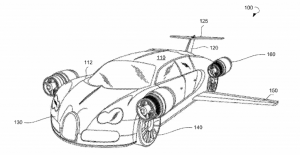 Amphibious Vertical Takeoff and Landing Unmanned Device
Amphibious Vertical Takeoff and Landing Unmanned Device
A vehicle operating as an aircraft but sized and designed to operate as a personal vehicle for carrying passengers is the focus of U.S. Patent No. 9776715, issued to a trio of independent inventors situated in Tiburon, CA, last October. It claims an amphibious vertical takeoff and landing (VTOL) unmanned device with an artificial intelligence (AI) data processing mobile and wearable apparatus. The amphibious vehicle is comprised of a modular and expandable waterproof body, an outer body shell, a gimbaled swivel propulsion system comprising a plurality of VTOL jet engines and VTOL ducted fans, solar cells for onboard electricity generation, a stabilizing tail and other sensor and electronic components. The unmanned device also includes foldable wings configured to create a pressure difference and parachutes configured to safely land the VTOL device in an emergency.
An improved design for point-to-point travel via air vehicle is disclosed by U.S. Patent Application No. 20180257448, filed by solo inventor Raymond Joseph Schreiner with the USPTO this September. It covers a modular air land vehicle that may be separated into air and land vehicle modules which may be operated together or separately. The air vehicle module of this invention is capable of interconnecting with the land vehicle module by landing directly on the road module, which may be stationary or in motion during interconnect. The invention provides the combined benefits of air and land travel without unduly increasing the weight or aerodynamic drag of the air vehicle.
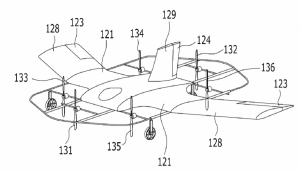 Multi-Stage Tilting and Multi-Rotor Flying Car
Multi-Stage Tilting and Multi-Rotor Flying Car
A flying car which combines the VTOL capability of rotary-wing aircraft like helicopters with the low energy consumption and high speeds of fixed-wing aircraft is discussed within U.S. Patent No. 9682772. Issued last June and assigned to EXENS of Seoul, South Korea, it claims a multi-stage tilting and multi-rotor flying car having a main frame externally shaped like a rectangle and internally partitioned to have a grid structure, a body mounted at the main frame’s center for balance, a plurality of rotors mounted to the main frame and facing upward, a plurality of wheels facing downward, body wings at opposite sides of the body and an automatic driving controller controlling the wheels and rotors. The resulting vehicle provides three times the flight time and speed and five times the flight distance of conventional rotary-wing aircraft while providing VTOL capabilities through the use of the rotors.
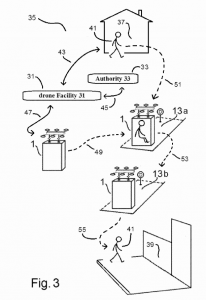 Drone Taxi Operation, Facilities & Management
Drone Taxi Operation, Facilities & Management
Those who don’t enjoy the salary level necessary to afford a personal flying car for their own convenience may be able to benefit from the drone taxi service that would be covered by U.S. Patent Application No. 20170116814, assigned to CIAS Inc. of New York City and filed in October 2016. It claims a propulsion and guidance apparatus to carry and delivery a customer according to a customer request to go from one location to a second location in a transportation drone taxi operational facility and system having a computer associated with the facility and at least two drone taxis each with an accommodation for a customer and each equipped with safety procedures. The resulting invention provides drone taxi pick-up and drop-off locations akin to subway stations and bus stops for the facilitation of drone taxi services as a form of public transportation.
 Systems and Methods for Improved Flight Control
Systems and Methods for Improved Flight Control
Flying cars are not the only types of assemblies being built to provide personal flight services as is evidenced by the technology outlined within U.S. Patent Application No. 20180127094, titled Systems and Methods for Improved Flight Control. Assigned to ZipAir SAS of Le Rove, France, and filed last November, it discloses a personal propulsion device having a platform configured to support a passenger, a sensor positionable within a passenger’s mouth to measure a bite force or bite pressure, a fire thrust system providing thrust in a first direction and a controller that adjusts the operation of the fire thrust system based in part on a received measurement of the bite force or pressure. The resulting invention provides a personal passenger propulsion device which can be used by a person to provide precision movement across land and water surfaces at high or low speeds.
Not every aerial vehicle technology with unmanned navigation systems is being developed for passenger transport, as is the case with the technology covered by the issue of U.S. Patent No. 10080318. Issued this September to NIO USA of San Jose, CA, it claims a system for charging an electric vehicle having a charging system including a power source and a charging plate wirelessly couple to the charging source, at least one shield portion between the charging plate and a passenger compartment of the electric vehicle and which is configured to attenuate an electromagnetic field provided by the charging system, and then an active cancellation management unit generating an electromagnetic field that at least partially opposes the electromagnetic field provided by the charging system and received within the passenger compartment. At least one embodiment of this invention provides for an unmanned aerial vehicle (UAV) which wirelessly provides a charge to an electric vehicle as it hovers over that vehicle.

![[IPWatchdog Logo]](https://ipwatchdog.com/wp-content/themes/IPWatchdog%20-%202023/assets/images/temp/logo-small@2x.png)

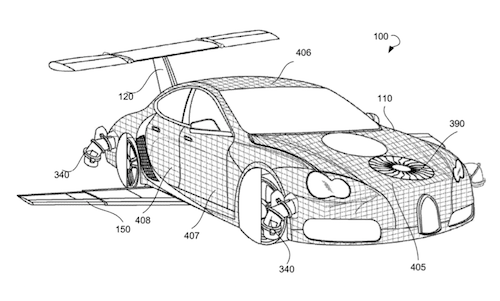
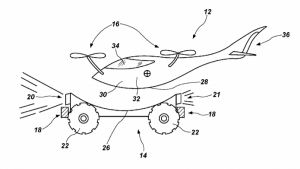
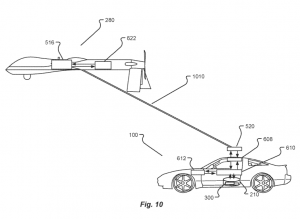
![[Advertisement]](https://ipwatchdog.com/wp-content/uploads/2024/05/Quartz-IP-May-9-2024-sidebar-700x500-1.jpg)
![[Advertisement]](https://ipwatchdog.com/wp-content/uploads/2024/04/Patent-Litigation-Masters-2024-sidebar-last-chance-700x500-1.jpg)

![[Advertisement]](https://ipwatchdog.com/wp-content/uploads/2021/12/WEBINAR-336-x-280-px.png)
![[Advertisement]](https://ipwatchdog.com/wp-content/uploads/2021/12/2021-Patent-Practice-on-Demand-recorded-Feb-2021-336-x-280.jpg)
![[Advertisement]](https://ipwatchdog.com/wp-content/uploads/2021/12/Ad-4-The-Invent-Patent-System™.png)






Join the Discussion
3 comments so far.
Mark Annett
September 30, 2018 08:12 amI am surprised this guy still has both his legs but this is a pretty cool attempt at a hover bike.
https://youtu.be/soxxPyaAT1k
Benny
September 30, 2018 08:02 amSome of those patents look as though they don’t meet the enabling requirement. The earliest patent for a flying car I found dates from 1947, and it describes a prototype which actually flew – the Convair 118.
The practicality of flying personal vehicles will probably hinge on the question of whether potential users are willing to pay for the huge expenditure of energy required to get air-borne. Where I live, the recent explosion in the popularity of e-bikes suggests the public prefers a more efficient transportation model.
Michael Palmer
September 30, 2018 07:10 amThanks, Steve, for pulling this together. Advances of the sort you describe sound like fantasy–until they arrive. And then they seem commonplace–because they are. (iPhone, Apple Watch, etc.)
In Clean Disruption (2014), Tony Seba predicted that most cars will be electric and autonomous by 2030. Others have said that we will soon switch from private ownership of cars that sit idle 90% of the time to pay-per-use vehicles that are on the road most of the time, thereby reducing total cost of ownership. The flying car will doubtless begin as a luxury item for the super wealthy. What role will it have in the transportation system generally?